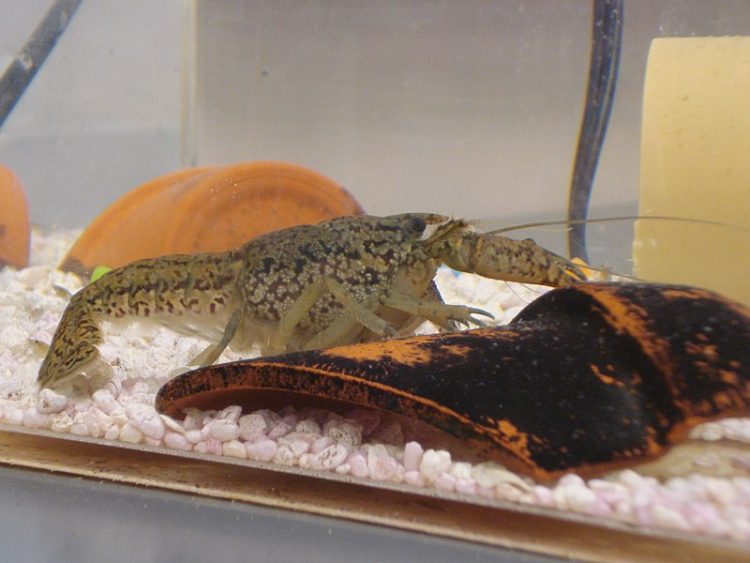The marbled crayfish or marmokreb, a mutant species that didn’t exist 25 years ago, is considered one of the most invasive freshwater creatures in the world, and it’s all due to its remarkable capacity to clone itself.
The rise of the the marbled crayfish as an internationally recognized invasive species can be traced back to the mid 1990s, when German aquarium hobbyist whom experts prefer not to identify, for privacy reasons, bought a large crayfish described to him as a “Texas crayfish”. The man was immediately stunned by its size and the enormous batches of eggs it could lay. He started bragging about it to his friends, and giving away specimens. Marmokreb-mania was in its infant stages, but as marbled crayfish started appearing in pet shops, aquarium hobbyists started noticing something peculiar…

Photo: Wikimedia Commons
All marbled crayfish specimens in existence were female, and didn’t seem to require a mate in order to produce large numbers of eggs. They just grew up ready to reproduce and would lay hundreds of eggs at a time. It was only in 2003 that scientists confirmed the marmokrebs’ ability to effectively clone themselves, and by that time, the crustacean was no longer just an aquarium animal, it had already started its quest for world domination.
It’s easy to understand how marbled crayfish wound up in lakes around Germany and then all over Europe. Hobbyists who started out with just a couple of specimens, quickly found themselves taking care of hundreds of them, and many simply dumped them in nearby bodies of water. It turned out that apart from its amazing cloning ability, the marmokreb was extremely adaptable, being able to thrive in the wild.
View this post on Instagram
Before long, feral populations of marbled crayfish were being reported across Europe, in countries like Hungary, Czech Republic, Croatia and Ukraine, as it became apparent that these amazing creatures could walk hundreds of yards to other lakes or streams, thus spreading at an alarming rate.
Whenever the reached new lands, the marbled crayfish needed a very short period of time to take over and smother endemic species into non-existence. In Madagascar, where it arrived in 2007, the population is now in the millions and very difficult to contain. The same was true for Japan and parts of the US, like Michigan, where the self-cloning crayfish has been banned, because of the risk it poses to local wildlife.
View this post on Instagram
Frank Lyko, a biologist at the German Cancer Research Center, told the New York Times that in certain lakes in Germany, marbled crayfish are so numerous that, on any given night, he and a few colleagues can catch over a hundred specimens with their bare hands.
“It’s extremely impressive,” said Dr. Lyko. “Three of us once caught 150 animals within one hour, just with our hands.”
View this post on Instagram
Dr. Lyko and his team were the first to sequence the genome of the marbled crayfish. They learned that it evolved from a species called the slough crayfish, Procambarus fallax, which can only be found in the tributaries of the Satilla River in Florida and Georgia. The first specimen resulted from the mating of two of these slough crayfish, one of which had a mutated sex cell. It had two copies of each chromosome, and somehow the two sex cells fused and produced a female crayfish embryo with three copies of each chromosome instead of the normal two.
Scientists aren’t sure how all the extra DNA didn’t cause any deformities in the resulting mutant crayfish, but she did get the ability to reproduce asexually and pass on identical copies of her three sets of chromosomes to her offspring, which were essentially clones.
Being a species made up of clones certainly has its advantages. Every individual marbled crayfish has the ability to produce only fertile specimens, which can help the species take over land areas very fast. In Madagascar, it managed to establish dominion over an area the size of Indiana in about a decade, at the expense of endemic crayfish species.
However, there are downsides to clones. For example, if a contagious disease were to develop the ability to affect the species, it could wipe it out entirely in a very short period of time. It’s doing quite well for now, but scientists are watching the species with great interest, to see how it does in the long-term.






